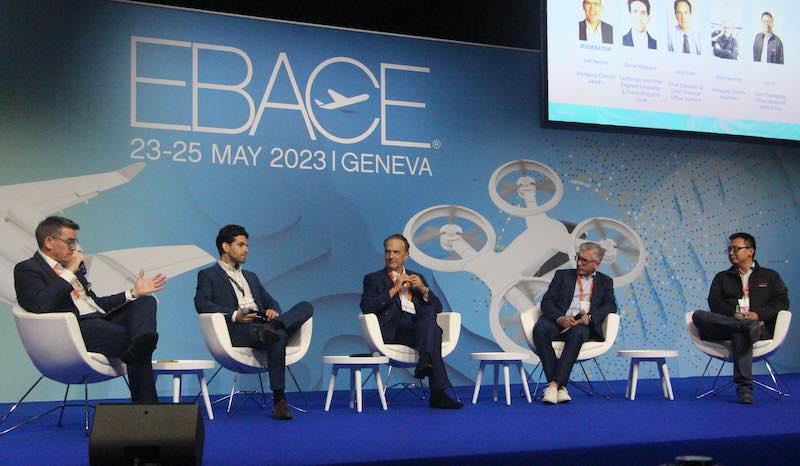
From left to right: Moderator Joel Hencks, of AeroEx, with panelists Daniel Wiegand, Jean Botti, Mark Henning and Jia Xu.
GENEVA–According to those working in the burgeoning advanced air mobility (AAM) sector, the question we should be asking about this new breed of air travel is not "if" but "when."
A panel discussion convened at EBACE 2023 to ask whether the aspiration to have certifiable AAM aircraft flying by 2025 reached an emphatic conclusion: absolutely yes.
However, the answer to a follow-up question—whether there will be any commercially viable business models ready to operate those certifiable aircraft by then—is less clear.
"There are very high requirements for pilots to fly our aircraft: this has to change," said Mark Henning, managing director of AutoFlight Europe, the German division of the Chinese startup that is developing the Prosperity family of electric vertical-takeoff-and-landing (eVTOL) vehicles.
"It's essential for people to understand out there, this is not a few crazy garage companies trying to build radio-controlled electrical aircraft and now putting people in them," Henning added.
As with so many big problems in aviation, development of viable AAM services will require multiple concurrent efforts, each bolstering progress in the other areas, each reliant on the other to move forward.
Technology readiness is only one—albeit critically important—aspect. Public perception and acceptance will be reflected in the pace of change of regulations, which will have to adapt if sufficient pilots are to be recruited and trained to allow operators to run fleets of sufficient size to offer a service that will be cheap enough to be accessible to a wide enough market to ensure that the public acceptance levels remain high. Finding a way to kick-start this process is not easy.
"If you look at our first aircraft, the Cassio 1, the first prototype—it had two electric motors in the wings, three in the back, plus one thermal engine. If you look at the new Cassio, it's a one-shot—single engine, two sources of energy. Why? To be able to have pilots who are normal pilots," said VoltAero's Jean Butti, a former CTO at Airbus who co-founded the electric-hybrid regional aircraft developer.
"This has to be worked out from the beginning, otherwise you enter into multi-engine [operations] and it's a different level of certification, a different level of training for the pilots," Butti continued. "This is exactly what you need to try to avoid as much as you can. From the first prototype to the one that will fly this year, this has changed completely our approach from the pilot-certification standpoint."
Another company that has changed its plans because of the challenges around pilot certification is Lilium, the German startup developing an electric jet.
"We've spent a lot of time thinking through this, and it was one of the reasons why we changed our business model a little bit," said Lilium co-founder Daniel Wiegand.
"We initially were targeting a commercial shuttle service with new infrastructure—we're still pursuing that target, but we ran into multiple challenges: how quickly can you get pilots, but also how quickly can you get infrastructure, for example," Wiegand said. "So we decided to initially focus on an existing market, targeting more the premium segment and customers who today buy airplanes. It's quite risky if you bet on everything being new."
As the levels of autonomy in aircraft control systems increase, the ability to simplify pilot controls also rises. Avionics supplier Honeywell believes that the key to unlocking the pilot-training problem lies in developing simpler control systems—a concept referred to in the AAM segment as simplified vehicle operation (SVO)—which will help encourage regulators to approve shorter, cheaper training packages.
"The initial operation pathway is in place," said Jia Xu, CTO of Honeywell's AAM business, arguing that the first operators will find aircrew for eVTOL platforms from within their pool of experienced conventional-aircraft pilots. "What we're very interested in is to figure out how we get to the state of simplified vehicle operations on a significant scale. That entails working with training companies and partners, as well as with regulators."
For all this to happen quickly enough to prevent OEMs having aircraft rolling off production lines years before there is a pilot cadre available to fly them, the young industry needs to stick together, Henning argued.
"We are all new, the sky is unlimited, this market is potentially so huge, and there's room for a lot of us," Henning said. "We shouldn't work against each other in the beginning. We can do that in 10 years when everybody's established—then we can fight. But for now, please, let's do this together."
